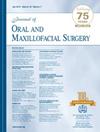Do Healing Rates Differ Between Medication-Related and Medication-Unrelated Osteonecrosis of the Jaw?
IF 2.6
3区 医学
Q2 DENTISTRY, ORAL SURGERY & MEDICINE
引用次数: 0
Abstract
Background
The healing rates, time to complete healing, effectiveness of operative therapy, and factors associated with healing for medication-related osteonecrosis of the jaw (MRONJ) and medication-unrelated osteonecrosis of the jaw (MUONJ) remain unclear.
Purpose
The study aimed to estimate and compare the healing rates between patients with MRONJ and MUONJ and identify prognostic factors associated with healing.
Study design, setting, sample
A 25-center prospective cohort study was performed—the investigators enrolled patients with ONJ treated using a standardized therapeutic protocol between 2013 and 2016. Patients with a history of radiation therapy to the jaws were excluded.
Predictor variable
The primary predictor variable was the ONJ diagnosis. The secondary predictors involved a set of heterogenous variables grouped into demographic, medical, clinical condition, and perioperative categories.
Main outcome variables
The primary outcome variable was treatment duration, defined as the time (in months) between therapy initiation and site healing, date of the final visit, or loss to follow-up.
Covariates
Not applicable.
Analyses
Descriptive statistics and cumulative healing rates were calculated. P < .05 was considered significant.
Results
The sample comprised 332 subjects with a mean age of 72.3 ± 11.1 years, among whom 116 (34.9%) were male. The MUONJ and MRONJ groups included 41 (12.3%) and 291 (87.7%) subjects, respectively, exhibiting 1-year cumulative healing rates of 92.1 and 47.3% (P < .01), respectively. The hazard ratio for complete healing was 3.7 (95% CI = 2.5 to 5.3, P < .01) in subjects with MUONJ compared with those with MRONJ. The median time to complete healing was 6 (3.8 to 8.2) months in the MUONJ group, while less than half of the subjects in the MRONJ group healed within 12 months. The 1-year cumulative healing rate was 92.1 and 47.3% (P < .01) in the operative therapy and nonoperative therapy groups, respectively.
Conclusions and Relevance
MUONJ was associated with better healing rates and a shorter time to healing compared with MRONJ. Operative therapy also showed potential benefits. Decisions for treating ONJ should be based on these findings alongside individual patient needs and conditions.
药物相关和非药物相关颌骨骨坏死的治愈率不同吗?
背景:药物相关性颌骨骨坏死(MRONJ)和非药物相关性颌骨骨坏死(MUONJ)的愈合率、完全愈合时间、手术治疗的有效性以及与愈合相关的因素尚不清楚。目的:本研究旨在评估和比较MRONJ和MUONJ患者的治愈率,并确定与愈合相关的预后因素。研究设计、环境、样本:进行了一项25个中心的前瞻性队列研究,研究人员招募了2013年至2016年间使用标准化治疗方案治疗的ONJ患者。有颌骨放射治疗史的患者被排除在外。预测变量:主要预测变量为ONJ诊断。次要预测因素包括一组异质性变量,分为人口统计学、医学、临床状况和围手术期类别。主要结局变量:主要结局变量是治疗持续时间,定义为治疗开始和部位愈合之间的时间(以月为单位),最后一次访问的日期,或失去随访。协变量:不适用。分析:计算描述性统计和累计治愈率。P < 0.05被认为是显著的。结果:样本共332例,平均年龄72.3±11.1岁,其中男性116例,占34.9%。MUONJ组和MRONJ组分别有41例(12.3%)和291例(87.7%),1年累计愈合率分别为92.1%和47.3% (P < 0.01)。与MRONJ患者相比,MUONJ患者完全愈合的风险比为3.7 (95% CI = 2.5 ~ 5.3, P < 0.01)。MUONJ组完成愈合的中位时间为6(3.8 - 8.2)个月,而MRONJ组中不到一半的受试者在12个月内愈合。手术治疗组1年累计治愈率为92.1%,非手术治疗组1年累计治愈率为47.3% (P < 0.01)。结论及相关性:与MRONJ相比,MUONJ具有更好的愈合率和更短的愈合时间。手术治疗也显示出潜在的益处。治疗ONJ的决定应该基于这些发现以及个体患者的需求和条件。
本文章由计算机程序翻译,如有差异,请以英文原文为准。
求助全文
约1分钟内获得全文
求助全文
来源期刊

Journal of Oral and Maxillofacial Surgery
医学-牙科与口腔外科
CiteScore
4.00
自引率
5.30%
发文量
0
审稿时长
41 days
期刊介绍:
This monthly journal offers comprehensive coverage of new techniques, important developments and innovative ideas in oral and maxillofacial surgery. Practice-applicable articles help develop the methods used to handle dentoalveolar surgery, facial injuries and deformities, TMJ disorders, oral cancer, jaw reconstruction, anesthesia and analgesia. The journal also includes specifics on new instruments and diagnostic equipment and modern therapeutic drugs and devices. Journal of Oral and Maxillofacial Surgery is recommended for first or priority subscription by the Dental Section of the Medical Library Association.
 求助内容:
求助内容: 应助结果提醒方式:
应助结果提醒方式:


